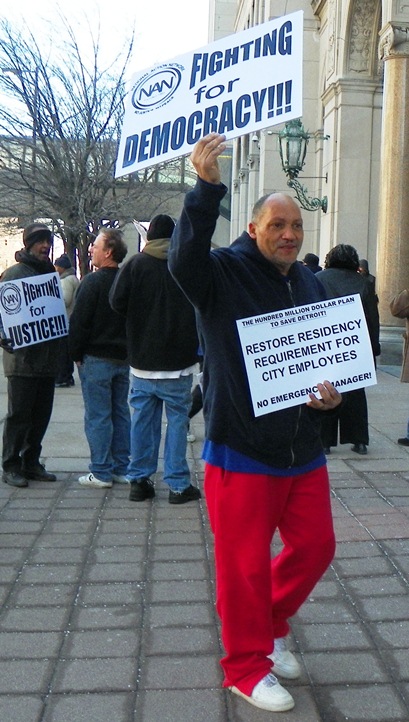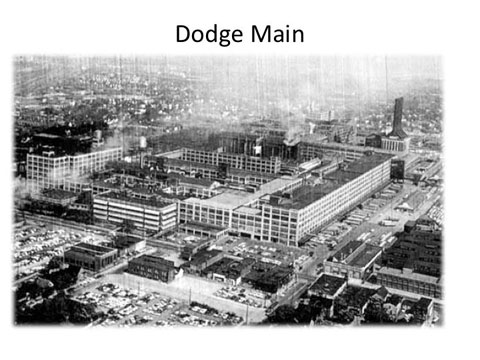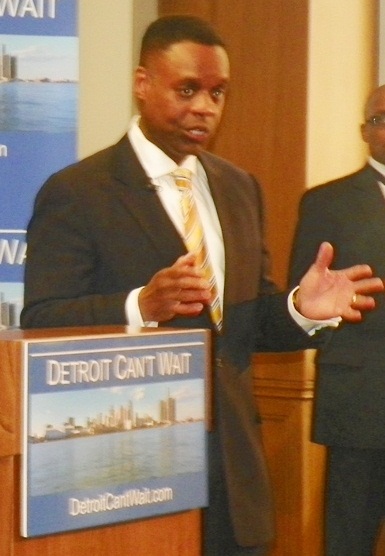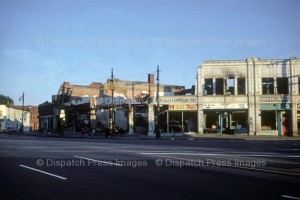“Policy Makers…cause the darkness: they created discrimination…perpetrated unemployment…property… the slum or the handy work of a vicious system…Negroes lived in them, but they do not make them any more than a prisoner makes a prison.” DR. MARTIN LUTHER KING, JR.
By Tyrone Travis
March 14, 2013
In the March 2, 2013, issue of the Detroit News, staff writer Darren A. Nichols, said “…Detroit’s…collapse…has been decades in the making.” Then, he told us that the fiscal crisis was caused by a “steady loss of population, over estimating revenues, spending more than taking in, borrowed money to pay debt.”
Mr. Nichols, Governor Rick Snyder and others keep telling us that population loss caused today’s fiscal crisis. But, intentionally don’t tell us that there are other sources that pay taxes and hire the majority of the population that pay taxes. The sources are the establishments: manufacturing, wholesale and retail that steadily left Detroit. Therefore, I make the loss of establishments and their consequences, my focus.
After World War II, the Federal government of the United State of America faced three (3) major problems:
- A Trade Crisis,
- A Cold War, and
- Immigration – Policies Caused Revenue Shortfall.
SECTION I. Trade Crisis and the Suburban Policy
During World War II, Western European Countries laid in ruins, as a result of those countries bombing each other’s industry and agriculture. Those countries spent their dollar and gold reserves buying food, arms, ammunition and other goods from American companies. When the war ended, there was a persistent imbalance in the International payments.
At that time, this imbalance was called a “Dollar Shortage.” (1) Countries conduct trade with each other, by each having a reserve of the other’s currency. The primary way countries acquire each other’s currency is through trade – selling and buying good from each other. Western Europe and Japan had no or very little dollars to buy American goods, and threatened to destroy the trade relationship between capitalist countries and capitalism itself.

Protester outside Gov. Rick Snyder’s press conference announcing Detroit takeover by EM March 14, 2013.
The Federal government adopted a policy to accept large quantities of imported goods from Western Europe and Japan. This allowed them to sell goods on American Markets, near duty free, earn dollars and keep trade alive.
Within the above trade policy, there was a Suburban Policy, where the Federal government adjusted the economy to accept abnormal quantities of imports, by encouraging manufacturing, commercial businesses and majority of the white population to move to the suburbs.
The Federal government used “…road construction money” (2) , to build expressways that enabled Detroit Auto companies to export capital out of Detroit by building 25 factories in the suburbs between “1947 to 1958 “(3) .
During the middle 1950’s, auto companies start moving their auto operations out of Detroit’s factories to their new factories in the suburbs. After 1962, manufacturing started closing in Detroit. The auto companies scattered their plants through-out suburban areas, with the aim of minimizing the impact imports would have on the employment rate in anyone area in the suburbs.
In 1954: “Northland Center, built by the J. L. Hudson Co., the First Suburban open-air shopping facility, open in Southfield… featuring many local stores, including Winkelman’s, Hughes & Hatcher, Cunningham’s Drugs, Sanders and Himeloch’s”.(4) In 1954: Eastland Center opens in Harper Woods, J. L. Hudson Co. is the developer, etc. This clearly showed how commerce was being moved out of Detroit.
In January 14, 1977, issue of the Detroit News, it was noted that “while 278 plants were being closed in Detroit, Macomb County gained 80 plants, Oakland County gained 151 and Western Wayne County gained 30”.

Chrysler’s Hamtramck Assembly Plant, better known as “Dodge Main,” closed Jan. 4. 1980 despite valiant efforts of UAW Local 3 workers to save it.
Former Mayor, Coleman A. Young, said “…the City of Detroit became abandoned to those who could not leave; it became a repository of the poor, the aged and the Blacks.”(5)
Detroiters were prevented from commuting and moving to the suburbs where the jobs existed because of two (2) policies: respectively, the policy that ended mass transit (184 streetcars) that ran from downtown Detroit throughout Southeast Michigan, and discriminatory Federal housing policies which forced the city’s residents to remain jobless in Detroit.
The aim or results of the above two policies shut Detroit residents out of the suburban labor market, where they would bear the effects of the trade policy – permanent loss of jobs and employment opportunities. This has been the condition in Detroit for over five (5) decades.
SECTION 2. Trade Crisis/Cold War, Deteriorated Tax Base and Jobless Crisis
I reiterate Section I, Trade Crisis and consider it with Section 2, Cold War because both problems that faced the Federal government after World War II were solved by the Suburban Policy.
“…the auto industry began to decentralize…frightened by the ensuing cold war and the hysteria evoked by the threat of atomic reprisal, began scattering its plants, into the suburbs and into other states far from Detroit. As a result, the city experienced a steady deterioration of its tax base…“.(6)
The income tax returns processed by the Income Tax Division of the City of Detroit, through calendar years 1971 to 2009 indicates that Detroit’s income tax base continued to deteriorate, as establishments left the city, as illustrated below.
Historically, this country was divided between the independent Free Farmers, in the Northeast, and Slave owning landowners, in the South. Therefore, the oldest major source of tax revenue was tax on land. George Leland Bach said “property tax on land and buildings were until World War II the most important single tax source in the United States.” (7) During World War II, employees earning wage income, increasingly out numbered farmers, at the same time, income tax actually became the tax base. In modern day capitalist societies, it goes without saying, the majority of the working age, residents in a given area, 16 to 64 years old must have a job and wage income to pay taxes, etc.

Detroit’s new EFM Kevyn Orr was among Jones Day lawyers representing Chrysler in its bankruptcy filing. Thirteen U.S. Chrysler plants closed, including 3 in the Detroit area.
The above numerical data on the exporting capital means, when auto companies built new factories in the suburbs, between 1947 and 1958, moved their operations and closed their factories in Detroit. The data on the history of the ever-decreasing employment rates is factual proof that the federal government’s suburban policies have generally eliminated Detroiters from the labor market.
As a result, the city government budget has had a consistent revenue shortfall, which made it necessary to borrow money to provide basic services for its residents. From 1973 to 2006, 46 unlimited obligation bond proposals were approved out of 56 ballot proposals in 33 years. The crisis of Residential Joblessness is the real cause of today’s fiscal crisis in Detroit and this is absolutely not Mr. Nichols or Governor Rick Snyder one-sided population pretext.
SECTION 3. 1965 Immigration Act/Small Business Administration Policy
Around the middle 1970’s, businessman Michael George, a Chaldean, formed a Metro Detroit Investment Co., which held a federal license and received “government aid to provide financing for small or minority entrepreneurs in disadvantaged neighborhoods,“(8) in Detroit. For 20 years between 1977 to 1997 Metro Detroit Investment existed, “nearly all loans it gave out were to … the Chaldean Community, which dominates… businesses in Detroit” (9) and “almost none of the loans went to African Americans.” (10)

Detroit’s Grand River, once a vibrant business strip, as it looks today. Many Black businesses have closed across the city.
The Federal government’s 1965 Immigration and Nationality Act and the Federal Small Business Administration Policy wiped out the Small Black retail businesses and have driven Black workers from small businesses in Detroit. This act and policy has replaced Blacks with Non-Resident-Immigrants, who pay no Detroit property taxes, no utility tax (for police service), no water/sewerage fees, etc. (VOD: for example, the exploitation of undocumented Mexican workers by Detroit contractors who use them in street construction and public landscaping.)
Declaration for Life
 The crisis in Detroit is residential Joblessness that was created by the Federal government policies. Emergency Financial Manager, Attorney Kevyn Orr’s, plan to turn around the Budget will be destructive for the residents in the City of Detroit. Destructive means GENOCIDE.
The crisis in Detroit is residential Joblessness that was created by the Federal government policies. Emergency Financial Manager, Attorney Kevyn Orr’s, plan to turn around the Budget will be destructive for the residents in the City of Detroit. Destructive means GENOCIDE.
The short term interest – all debt owed Detroit by State government and the private sector must be paid to Detroit immediately. The long term interest – capital investment in full employment for Detroit residents or the Federal Government must face its responsibility for the destructive consequences of its suburban policy on the residents of Detroit by creating a “guarantee income” for Detroiters. “(10)
Notes
1. “A Trade and Tariff Policy in the National Interest”, by the Public Advisory Board for Mutual Security, Washington: Feb. 1953. Page 61-67
2. “Detroit Free Press 2-10-1993 Page 8A (construction)
3. “The Detroit Almanac, 2001, 2001 by Detroit Free Press Page. 302
4. The Detroit News Page 7A, May 23, 2009
5. Ebony Magazine Feb 1974, “If Detroit collapses, the State will also,” by Coleman . A. Young
6. Ibid
7. Economics – Seventh Edition by George Leland Bach
8. The Detroit News Page 1 and 9, 12/27/1999
9. Ibid
10. Ibid
11. Where Do We Go From Here – chaos or community, by Dr. Martin Luther King, Jr.










Diane This is EXCELLENT!
Hi
Can’t believe all of my friends are leaving me. Let me go back….HOW ARE YOU? Please feel free to contact me at 313-465-3299….I had your number and lost it when the phone died…we must get together. I understand Valerie Burgess is planning a memorial in the spring of this year. I would like to definitely be apart of it as you know Tyrone, You and I wrote a number of papers together. (LOL)